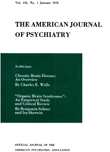A TEST WHICH PREDICTS THE CLINICAL EFFECTS OF ELECTRIC SHOCK TREATMENT ON SCHIZOPHRENIC PATIENTS
Abstract
(1) Individuals vary in their autonomic patterns. Seven patterns are described. Eighty percent of the controls not under stress fall into 2 autonomic groups that contain only 19% of the mentally ill. These [see Fig. 18. in Source PDF] FIG. 18.—Clinical and autonomic changes in a case of schizophrenia in Group I with no anxiety before or during the test. [see Fig. 19. in Source PDF] FIG. 19.—Clinical and autonomic changes in a case of schizophrenia with both favorable and unfavorable factors. The patient improved but relapsed shortly after treatment was stopped. In this case anxiety was relaxed by mecholyl but precipitated by epinephrine. patterns can be altered by electric shock. (However, these changes are not specific for electric shock, as they occur with other modes of therapy and with spontaneous changes in the patient's psychological picture.) The question of cause will immediately come to the mind of many. With that question we are not concerned in this paper except to state that the psychological and physiological seem to be parts of the same process. When the psychological picture changes, the physiological picture changes and vice versa. They seem to fit as a "hand into a glove."
(2) The autonomic patterns are not specific for any diagnostic category. Of the clinical entities we have studied, schizophrenia alone covers all the autonomic groups. However, there is some affinity of certain diagnostic categories for particular autonomic groups, i. e., the distribution is not random; for example, the great majority of Group IV are neurotics, the great majority of Group VI are agitated depressions or manic-depressive depressed patients. While schizophrenics fall into all groups, there is a preponderance of these cases in Groups I and III. Cases in Group V are usually diagnosed as dementia præcox, catatonic type. If the dementia præcox patient falls into Group VI or VII where the majority of the manic-depressives and involutional psychoses fall, he usually improves with electric shock; if, however, the schizophrenic falls into any of the other autonomic groups, he usually does not improve with electric shock.
(3) Our "psychophysiological responses" also appear to cut across clinical diagnostic labels. If the patient, schizophrenic or not, has anxiety precipitated by epinephrine, he is not likely to improve with electric shock. If, however, anxiety is precipitated by mecholyl, or relieved by mecholyl, or a chill occurs after mecholyl, the patient usually improves with electric shock regardless of the clinical diagnosis.
(4) There are definite autonomic changes with electric shock, i. e., provided the clinical picture changes. These are: (a) increased reaction to epinephrine, (b) decreased reaction to mecholyl, (c) decreased basal blood pressure, and (d) changed blood pressure grouping.
We believe that the over-all effect of electric shock treatment is to lower the basal sympathetic tension, especially if it has been increased by the illness, and at the same time increase the reactivity of the sympathetic nervous system to stimulation. Decreased reaction of the parasympathetic nervous system to stimulation is often a corollary. We would like to emphasize again that these changes are physiological concomitants of the psychological changes and we have no evidence that they are in any way causal.
(5) If an anxiety component is present in terms of our test, the following are the likely changes following electric shock treatment: (a) anxiety precipitated by epinephrine is increased; (b) anxiety precipitated by mecholyl is relieved; (c) anxiety temporarily relaxed by mecholyl presages a good result with electric shock; and (d) a chill after mecholyl is abolished.
From our studies we can predict that a good outcome with electric shock treatment may occur in cases that show some of the following features: (a) initial autonomic grouping VI or VII; (b) anxiety precipitated or relaxed by mecholyl; and (c) a chill after mecholyl.
(6) A word of caution: The cases that were shown as examples were the most typical in order to give a clear impression. In many cases there is a combination of factors; for example, a person may fall into a "shock-sensitive" group and have anxiety of the type precipitated by epinephrine. Judging from the autonomic grouping, we might predict a good outcome; on the other hand, epinephrine-precipitable anxiety usually suggests a poor outcome. Much more experience is necessary in order to predict the changes in such complex cases.
Access content
To read the fulltext, please use one of the options below to sign in or purchase access.- Personal login
- Institutional Login
- Sign in via OpenAthens
- Register for access
-
Please login/register if you wish to pair your device and check access availability.
Not a subscriber?
PsychiatryOnline subscription options offer access to the DSM-5 library, books, journals, CME, and patient resources. This all-in-one virtual library provides psychiatrists and mental health professionals with key resources for diagnosis, treatment, research, and professional development.
Need more help? PsychiatryOnline Customer Service may be reached by emailing [email protected] or by calling 800-368-5777 (in the U.S.) or 703-907-7322 (outside the U.S.).



